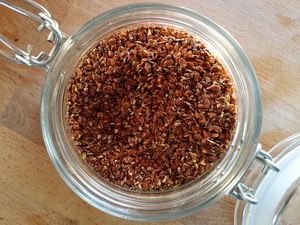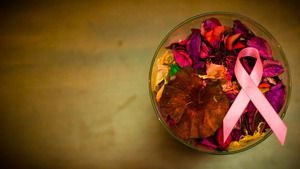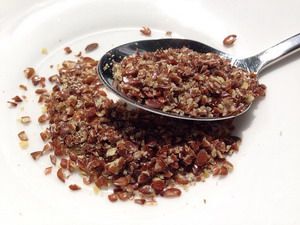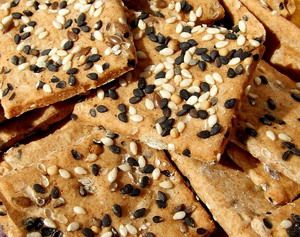I have been fasting for two weeks now, doing what I am now calling the Full Belly Fast. It is a very different experience for me compared to my usual water fasting. It does not even feel like fasting because I am eating several times a day. I always have a full belly. Normally with water fasting you are not actually hungry, but your empty belly can feel like it wants something in it. By eating a ton of vegetables it is always full, even though my calorie consumption is below 500 calories each day.
When I started this fast I knew I wanted to be sure I was getting plenty of fiber to mop up the poisons that the liver would dump into the small intestines. As I researched fiber levels of the vegetables I was planning to eat, I found that veggies don’t really have all that much fiber. They are mostly water with a touch of fiber. Further searching revealed to me that the absolute highest fiber food humans would ever normally eat is flaxseeds. This was a good find because I already knew that the most important fiber I wanted for liver toxin removal was called lignans, and flax was the best source of lignans.
 So I have been eating flax crackers or flax bread or even flax muffins every day. They are incredibly filling because of the high fiber intake, and they go well with the bone broth vegetable stew I eat three times a day.
So I have been eating flax crackers or flax bread or even flax muffins every day. They are incredibly filling because of the high fiber intake, and they go well with the bone broth vegetable stew I eat three times a day. In the course of researching flax lignans, I uncovered a bunch of research on the health benefits of flax lignans. In a nutshell the three biggest benefits are its anti-cancer properties, heart health, and bone health.
Flaxseed contains roughly 1 to 2% lignans. Lignans appear in lots of different foods like cereals (rye especially), legumes, fruits, and vegetables. But the levels of lignans in flax are thousands of times higher than these sources. Sesame is the only other source that comes close with about one tenth as much as flax. The different lignans in foods are converted into the kind of lignans our body can use by the bacteria in our gut – another reason we need healthy gut bacteria.
than these sources. Sesame is the only other source that comes close with about one tenth as much as flax. The different lignans in foods are converted into the kind of lignans our body can use by the bacteria in our gut – another reason we need healthy gut bacteria.
 than these sources. Sesame is the only other source that comes close with about one tenth as much as flax. The different lignans in foods are converted into the kind of lignans our body can use by the bacteria in our gut – another reason we need healthy gut bacteria.
than these sources. Sesame is the only other source that comes close with about one tenth as much as flax. The different lignans in foods are converted into the kind of lignans our body can use by the bacteria in our gut – another reason we need healthy gut bacteria.The beneficial effect from lignans seems to be because they are phytoestrogens; they weakly attach to estrogen receptors on cells in our body. This has a balancing effect on the body. If you have too much estrogen then this prevents this excess estrogen from binding to receptors and turning on too many switches in cells. If you don’t have enough estrogen, the phytoestrogens will act as a weak stand in for the estrogen you are missing.
 For many years there was a lot of confusion about phytoestrogens and their effect on estrogen sensitive breast cancers. The fear was that phytoestrogens could trigger breast cancer. Well the research is now in and good levels of phytoestrogens are now known to protect against breast cancer, but low levels may be a trigger.
For many years there was a lot of confusion about phytoestrogens and their effect on estrogen sensitive breast cancers. The fear was that phytoestrogens could trigger breast cancer. Well the research is now in and good levels of phytoestrogens are now known to protect against breast cancer, but low levels may be a trigger.As a guy, of greater interest to me is that flax lignans are found to protect against prostate cancer. Other studies show similar protective effects for colon cancer, skin, and liver cancer. In fact one lignan was found to be so effective that it has been modified and turned into a chemotherapy drug to fight cancer.
 Cardiovascular protection – one study found that flax lignans reduced atherosclerosis (plaque hardening the arteries) by 69%. That is huge! It also is found to improve how sensitive your cells are to insulin which helps reverse metabolic syndrome and ultimately diabetes.
Cardiovascular protection – one study found that flax lignans reduced atherosclerosis (plaque hardening the arteries) by 69%. That is huge! It also is found to improve how sensitive your cells are to insulin which helps reverse metabolic syndrome and ultimately diabetes.With bones, lignans are found to help prevent osteoporosis. These effects were noted most significantly when the levels of consumption were greater than 90 mg per day. Since flax is generally 1 to 2% lignans, that would mean eating 5 to 10 grams of flax per day – not that hard to do.
While I was shopping around for flaxseed flour for myself, (Costco used to carry it but doesn’t any more) I came across flax lignans being sold by themselves. I am having to admit that most of my patients will not actually ever bake flaxseed muffins or make flax crackers, even though they are very easy to make. So to get the great health benefits of lignans, many companies sell the lignans as a pill or in powder form for sprinkling over yogurt, cereal, or in your smoothies.
 Since I am excited about food sources of health giving nutrients, I decided that I wanted to put flax lignans in the office for my patients. Most of the products I have seen on the internet are rather expensive, as most healthy natural food concentrates and extracts tend to be. But I found a wholesale source of bulk flax lignans that will enable me to package up the lignan in 1/3 pound containers for only $24. One serving is a teaspoon or two and a 1/3 pound container has about 75 teaspoons in it. So for the benefit, the price is really good and you won’t have to cook or bake to reap those benefits.
Since I am excited about food sources of health giving nutrients, I decided that I wanted to put flax lignans in the office for my patients. Most of the products I have seen on the internet are rather expensive, as most healthy natural food concentrates and extracts tend to be. But I found a wholesale source of bulk flax lignans that will enable me to package up the lignan in 1/3 pound containers for only $24. One serving is a teaspoon or two and a 1/3 pound container has about 75 teaspoons in it. So for the benefit, the price is really good and you won’t have to cook or bake to reap those benefits.For those of you that do like to cook and bake, I heartily recommend making some flax crackers or flax muffins. Flax combines nicely with other grain flours and nut flours. Flax flour is often  commonly used as a replacement for eggs or oil in many recipes as it provides a lot of moisture to the final product. I made some flax muffins a couple days ago using a 50/50 mix of almond and flax flours and used my Double Sugar and a tablespoon of molasses, plus a few dried cranberries as a sweet treat for Ellen.
commonly used as a replacement for eggs or oil in many recipes as it provides a lot of moisture to the final product. I made some flax muffins a couple days ago using a 50/50 mix of almond and flax flours and used my Double Sugar and a tablespoon of molasses, plus a few dried cranberries as a sweet treat for Ellen.
 commonly used as a replacement for eggs or oil in many recipes as it provides a lot of moisture to the final product. I made some flax muffins a couple days ago using a 50/50 mix of almond and flax flours and used my Double Sugar and a tablespoon of molasses, plus a few dried cranberries as a sweet treat for Ellen.
commonly used as a replacement for eggs or oil in many recipes as it provides a lot of moisture to the final product. I made some flax muffins a couple days ago using a 50/50 mix of almond and flax flours and used my Double Sugar and a tablespoon of molasses, plus a few dried cranberries as a sweet treat for Ellen.Be careful though, flax muffins are really good so you have to be careful not to eat too many. Flax is mostly fiber. Most Americans only get an average of 5 grams of fiber a day. A minimum for health is 25 to 30 grams a day, but if your system is not used to it, it can give you a lot of gas until you build the populations of the right gut bacteria to deal with it. So build up your fiber intake slowly. This would not be an issue with the flax lignans by themselves.
So I am going to get the flax lignans in the office as soon as possible. If you want to protect your arteries, bones, and decrease various cancers, then grab some flax lignans and add it to your daily diet.
